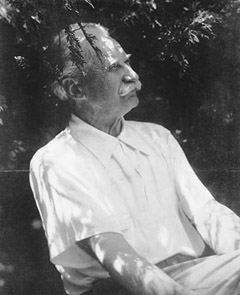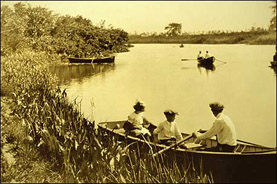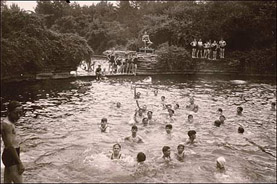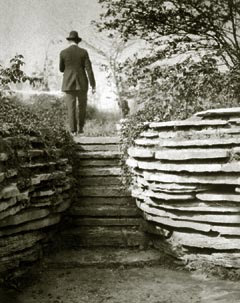
Jens Jensen, 1943. Courtesy Chicago Park District Special Collections
Jens Jensen, described as the dean of the world’s landscape architects by the New York Times when he died in 1951, believed that experiences in the natural world were essential for the human soul.
Born in 1860 in Denmark, Jensen came to the United States in 1884. He was hired as a street cleaner for Chicago’s West Park Commission, and quickly worked his way up in the system as a landscaper and supervisor. In 1888, Jensen created an “American Garden” by gathering wagonloads of wildflowers (many of which were then considered weeds) and transplanting them into a corner of Union Park along with native trees and shrubs. It was the first natural garden in any large park in the country. Jensen felt that creating public parks was the meaning of his life, but when he refused to stop fighting political corruption in the city, he was fired in 1900.
During this time, Jensen was also active in progressive social and environmental organizations, where he made many friends. When he lost his job, Jensen began a private practice working mainly on large estates along Chicago's north shore. Soon he became known for a distinctive regional approach characterized as the prairie style of landscape architecture. Jensen worked with Louis Sullivan, George W. Maher, and Robert Spencer, architects whose buildings reflected the broad horizontal lines of the Midwest, and collaborated with Frank Lloyd Wright on a number of projects. Wright had high praise for Jensen, calling him a native nature poet.
In 1905, Jens Jensen was rehired to revitalize deteriorating Chicago Parks. By 1916, he completed a design for Columbus Park, considered one of his enduring masterpieces. It was a project Jensen undertook from the heart—in response, he once said, "to the enchantment of the message of the prairies." Instead of traditional playground equipment, areas were designed for creative play in wild natural settings. For outdoor drama and pageants, Jensen set a player's hill on the rise between two brooks. The plan also included two of Jensen's trademark council rings—low, circular, stone seats set around a fire pit, resembling Native American council fires or campfires of pioneers crossing the prairie. These were to be used for storytelling, conversation, or music. Jensen saw the council rings as a symbol of democracy, encouraging companionship with others and with nature.
 Jensen found many ways to incorporate water into his landscape plans. In Columbus Park, he created one of his natural prairie rivers bordered by masses of meadow vegetation.
Courtesy of Chicago Parks District Special Collections
Jensen found many ways to incorporate water into his landscape plans. In Columbus Park, he created one of his natural prairie rivers bordered by masses of meadow vegetation.
Courtesy of Chicago Parks District Special Collections |
 The rustic swimming pools, with their walls of natural horizontal limestone ledges planted with plants in the crevices, were designed to allow city children to experience native swimming holes. Courtesy of Chicago Parks District Special Collections
The rustic swimming pools, with their walls of natural horizontal limestone ledges planted with plants in the crevices, were designed to allow city children to experience native swimming holes. Courtesy of Chicago Parks District Special Collections
|
In 1935, after the death of his wife, Jens Jensen left Chicago to build a school called The Clearing on a remote northern tip of Wisconsin Door County, where students were encouraged to learn by doing, learn from one another, and care for the environment. Until he died at 91, Jensen continued to explore the landscape with visitors and students, sharing his belief that nature stirs and quiets the soul, provides nourishment for the imagination, and promotes inner harmony.

Jens Jensen in Columbus Park. Jensen's compositions with
stone echo
natural rock formations. He called them "planted stones." Courtesy of Special Collections, Sterling Morton Library, The Morton Arboretum |
"There is a remarkable nobility in rocks, weather-beaten and worn by water of past ages. Rocks, like trees, have a character all their own …"
-- Jens Jensen, Siftings |
|